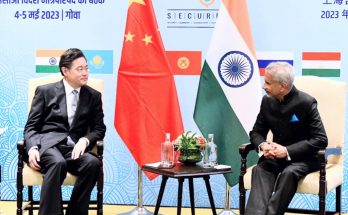 The new Indian government, probably for the first time, seems to be recalibrating its stance towards adopting a structured policy towards the Indian Ocean Region (IOR), which hitherto carried no more significance than an anagrammatic similarity between the region and the country. The pre-election promise of the Sagar Mala Project in BJP manifesto, the push to demilitarise the Indian Ocean (IO) through the Galle Dialogue in 2014, Prime Minister’s heightened focus on its littoral neighbours, and most recently Prime Minister Modi’s visit to three island countries (Seychelles, Mauritius and Sri Lanka), which did not figure prominently in India’s regional geopolitical calculus, corroborate India’s intended policy seriousness towards the IOR.
The new Indian government, probably for the first time, seems to be recalibrating its stance towards adopting a structured policy towards the Indian Ocean Region (IOR), which hitherto carried no more significance than an anagrammatic similarity between the region and the country. The pre-election promise of the Sagar Mala Project in BJP manifesto, the push to demilitarise the Indian Ocean (IO) through the Galle Dialogue in 2014, Prime Minister’s heightened focus on its littoral neighbours, and most recently Prime Minister Modi’s visit to three island countries (Seychelles, Mauritius and Sri Lanka), which did not figure prominently in India’s regional geopolitical calculus, corroborate India’s intended policy seriousness towards the IOR.
Why the visit?
A series of steps by the Modi government has focused on improving its relations with not just its immediate neighbours, but also countries seen as part of the extended neighbourhood. Mr Modi’s five-day visit to the three key Indian Ocean countries has deep diplomatic and strategic significance. His visit to these countries intends to build on his government’s two-pronged approach; an unequivocal earnestness to better relations with its neighbours while simultaneously enhancing the country’s military profile in the region. India is also driven by its desire to mend relations with the strategically important countries in the Indian Ocean with whom China has come to be very close in the recent past, even as India sat on its Indian Ocean strategy. With his current visit, Modi intends to make up for at least three decades of lost time in India’s diplomacy towards these countries.
The China Subtext
Under the veneer of this benign diplomacy, there is a potent undercurrent of strategic immediacy in New Delhi’s behaviour, catapulted by certain geopolitical developments in the IOR. These developments are pivoted around China’s increasing presence in the Indian Ocean, particularly in those countries that surround India, littoral or otherwise. The fears about Chinese submarines foraying into the Indian Ocean came true with the strategic docking of the Changzheng-2 along with its warship Chang Xing Dao at a port in Colombo in October last year, just two months after a previous submarine docking. The increasing Chinese influence in Gwadar is another concern that has raised hackles in India.
In China’s Maritime Silk Road (MSR), India sees a long-term and probably more debilitating strategy vis-à-vis itself. Under the MSR China has pledged to build and improve maritime infrastructure in friendly countries in South Asia, thereby improving the possibility that any such move would dent India’s own strategic hedge apropos those countries.
India’s Response
The IO has never been the seat of great power rivalry hitherto, despite the presence of major powers and it being the most nuclearised ocean in the world. This can largely be accorded to India’s own benign security approach towards the IOR, apart from the Indian Ocean being a global trade transit corridor.
India’s open announcement about the possibility of striking new understandings in areas of defence and economic spheres with the three Indian Ocean countries has changed the prism through which the co-presence of India, China and the US (which is still the predominant power in this region) in the IO will be looked at. Add to this, India’s enhanced military profile in the region and its defence exports to strategic countries in the IO. Building and bolstering the Andaman and Nicobar Command (ANC) and the enhanced profile of the Indian Navy have indicated India’s deep desire to play a net security provider in the IO.
Prime Minister Moodi’s visit has been concomitantly accompanied by the deployment of its two formidable carrier battle groups led by aircraft carrier INS Vikramaditya and INS Virat along with seven warships to keep a close vigil on the Indian Ocean Region (IOR). A day before this three-nation visit started, two battle group along with warships from India’s Western fleet, armed with fighter jets, helicopters, reconnaissance planes, missiles and other weaponry reached Kochi. There possibly aren’t many ways to interpret this move, than a clear signal of reassurance to these Indian Ocean nations about India’s seriousness and capability to provide for maritime security in this region.
An Impending Great Game?
With India having thrown the gauntlet in the security dynamics of the IO, its geostrategic repercussions have to be inevitably factored in. India’s entry in the IO with its security apprehensions and military paraphernalia will make the IO the new kid on the strategic rivalry bloc, with the Asia-Pacific leading the way. The current undertones of strategic rivalry in the Indian Ocean stand somewhat like this: the US remains the predominant military power of the region with its strategic (connecting US 5th Fleet and 7th Fleet) Military Support Facility (MSF), Diego Garcia. Besides, the US Fifth Fleet is directly responsible for the IOR; China has slowly been inching towards the western side of the IO from its south-eastern peripheries creating flutters for regional powers like India and extra-regional powers like the US, alike. The UK’s announcement that the Royal Navy’s aircraft carriers, nuclear submarines, destroyers and other logistic support vessels will be deployed in the Indian Ocean and operate from Bahrain, together with the ‘French Quadrilateral’ make up for an interesting geostrategic mix in the IO.
India-US-China triangle
However, the real contestation for resources and place is likely to emanate from the India-China-US triangle in the Indian Ocean. India’s leasing of Assumption Island from Seychelles and the proximity of Mauritius places India in an unprecedented geographical proximity to Deigo Garcia. If the US-India relations continue in the present trajectory, it can be speculated that Assumption Island under India can replicate a few military facilities from the nearby US’ MSF. Geographically, the Seychelles-Mauritius-Diego Garcia form a crucial triangle in the heart of the global trade transit route, used by China more than any other country and likely to be used more if the MSR project fructifies. While China is likely to vie with both India and the US to establish itself more concretely in the Indian Ocean, the US will advocate a larger security role for India, even as it would want the IO to be a part of its Rebalance strategy. For India, although edging out China from these IO countries to create a space for itself will be a challenge, the current visit has the potential to upset China’s strategic apple cart in the Indian Ocean region.
(The views expressed in this article are solely those of the author)
Author Profile
- India Writes Network (www.indiawrites.org) is an emerging think tank and a media-publishing company focused on international affairs & the India Story. Centre for Global India Insights is the research arm of India Writes Network. To subscribe to India and the World, write to editor@indiawrites.org. A venture of TGII Media Private Limited, a leading media, publishing and consultancy company, IWN has carved a niche for balanced and exhaustive reporting and analysis of international affairs. Eminent personalities, politicians, diplomats, authors, strategy gurus and news-makers have contributed to India Writes Network, as also “India and the World,” a magazine focused on global affairs.
Latest entries
 India and the WorldMay 3, 2024Trump 2.0 or Biden 2.0, India-US ties will get better & stronger: Aparna Pande
India and the WorldMay 3, 2024Trump 2.0 or Biden 2.0, India-US ties will get better & stronger: Aparna Pande DiplomacyApril 23, 2024Resetting West Asia, re-booting the world, but not fast enough: T.S. Tirumurti
DiplomacyApril 23, 2024Resetting West Asia, re-booting the world, but not fast enough: T.S. Tirumurti India and the WorldApril 22, 2024India’s G20 Legacy: Mainstreaming Africa, Global South in global agenda
India and the WorldApril 22, 2024India’s G20 Legacy: Mainstreaming Africa, Global South in global agenda DiplomacyApril 10, 2024Diplomat-author Lakshmi Puri pitches for women power at LSR
DiplomacyApril 10, 2024Diplomat-author Lakshmi Puri pitches for women power at LSR







